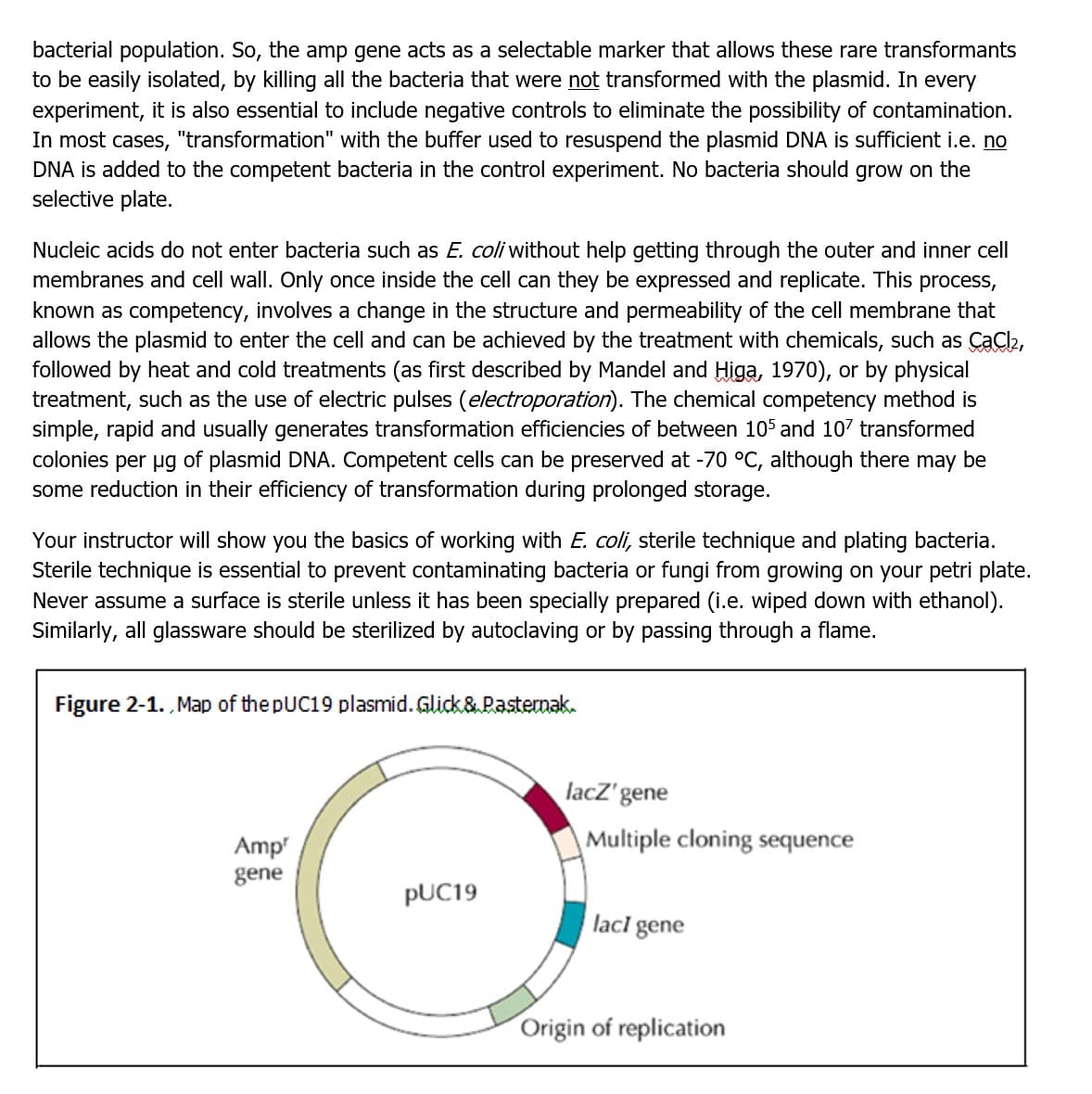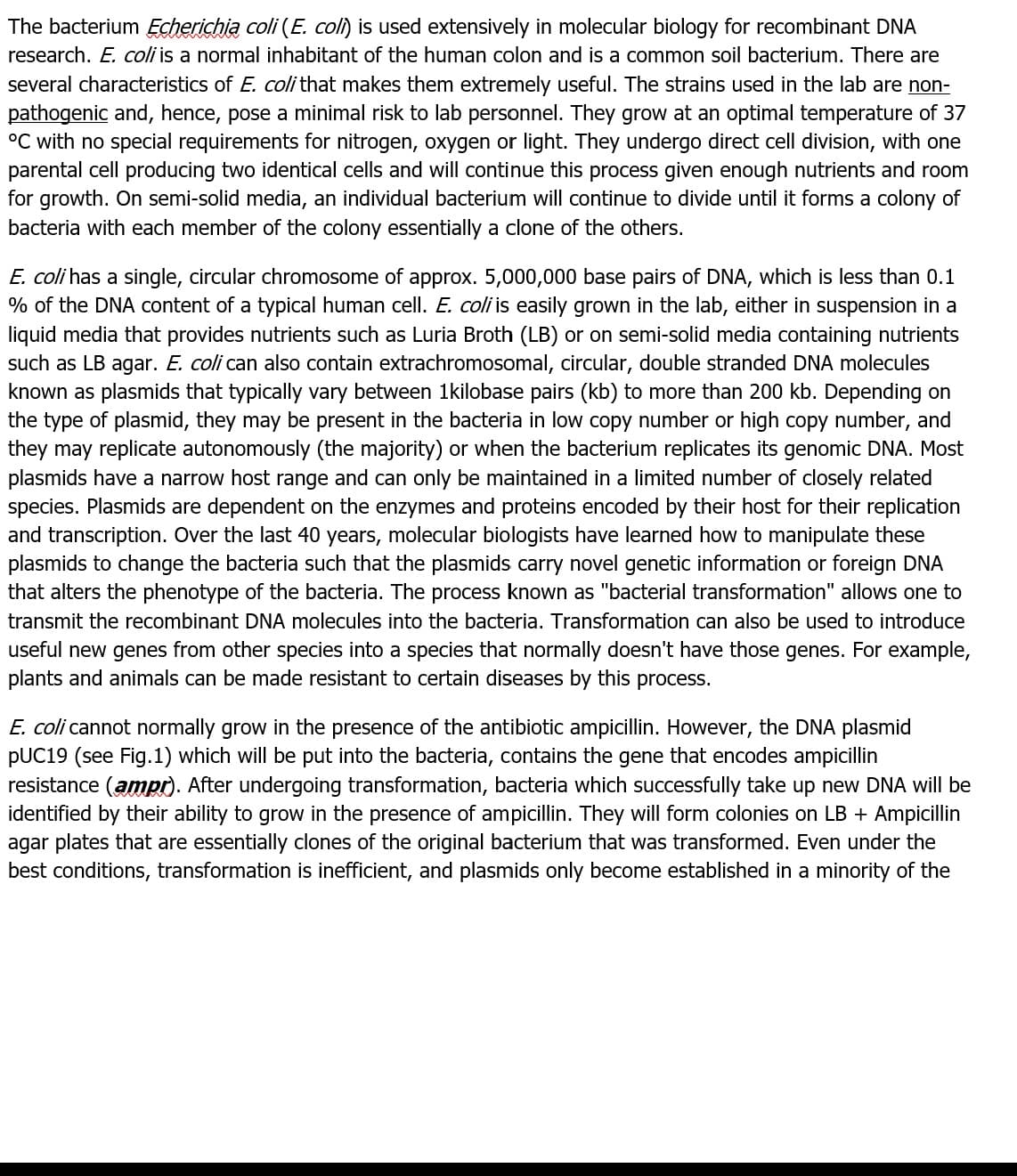Human Anatomy & Physiology (11th Edition)
11th Edition
ISBN:9780134580999
Author:Elaine N. Marieb, Katja N. Hoehn
Publisher:Elaine N. Marieb, Katja N. Hoehn
Chapter1: The Human Body: An Orientation
Section: Chapter Questions
Problem 1RQ: The correct sequence of levels forming the structural hierarchy is A. (a) organ, organ system,...
Related questions
Question
notes are attached below for further information
Define the term competent cells as it relates to this laboratory.

Transcribed Image Text:bacterial population. So, the amp gene acts as a selectable marker that allows these rare transformants
to be easily isolated, by killing all the bacteria that were not transformed with the plasmid. In every
experiment, it is also essential to include negative controls to eliminate the possibility of contamination.
In most cases, "transformation" with the buffer used to resuspend the plasmid DNA is sufficient i.e. no
DNA is added to the competent bacteria in the control experiment. No bacteria should grow on the
selective plate.
Nucleic acids do not enter bacteria such as E. coli without help getting through the outer and inner cell
membranes and cell wall. Only once inside the cell can they be expressed and replicate. This process,
known as competency, involves a change in the structure and permeability of the cell membrane that
allows the plasmid to enter the cell and can be achieved by the treatment with chemicals, such as CaCl2,
followed by heat and cold treatments (as first described by Mandel and Higa, 1970), or by physical
treatment, such as the use of electric pulses (electroporation). The chemical competency method is
simple, rapid and usually generates transformation efficiencies of between 105 and 107 transformed
colonies per ug of plasmid DNA. Competent cells can be preserved at -70 °C, although there may be
some reduction in their efficiency of transformation during prolonged storage.
Your instructor will show you the basics of working with E. coli, sterile technique and plating bacteria.
Sterile technique is essential to prevent contaminating bacteria or fungi from growing on your petri plate.
Never assume a surface is sterile unless it has been specially prepared (i.e. wiped down with ethanol).
Similarly, all glassware should be sterilized by autoclaving or by passing through a flame.
Figure 2-1. „Map of the pUC19 plasmid. Glick& Pastemak.
lacZ' gene
Amp"
Multiple cloning sequence
gene
PUC19
lacI gene
Origin of replication

Transcribed Image Text:The bacterium Echerichia coli (E. coli) is used extensively in molecular biology for recombinant DNA
research. E. coli is a normal inhabitant of the human colon and is a common soil bacterium. There are
several characteristics of E. coli that makes them extremely useful. The strains used in the lab are non-
pathogenic and, hence, pose a minimal risk to lab personnel. They grow at an optimal temperature of 37
°C with no special requirements for nitrogen, oxygen or light. They undergo direct cell division, with one
parental cell producing two identical cells and will continue this process given enough nutrients and room
for growth. On semi-solid media, an individual bacterium will continue to divide until it forms a colony of
bacteria with each member of the colony essentially a clone of the others.
E. coli has a single, circular chromosome of approx. 5,000,000 base pairs of DNA, which is less than 0.1
% of the DNA content of a typical human cell. E. coli is easily grown in the lab, either in suspension in a
liquid media that provides nutrients such as Luria Broth (LB) or on semi-solid media containing nutrients
such as LB agar. E. coli can also contain extrachromosomal, circular, double stranded DNA molecules
known as plasmids that typically vary between 1kilobase pairs (kb) to more than 200 kb. Depending on
the type of plasmid, they may be present in the bacteria in low copy number or high copy number, and
they may replicate autonomously (the majority) or when the bacterium replicates its genomic DNA. Most
plasmids have a narrow host range and can only be maintained in a limited number of closely related
species. Plasmids are dependent on the enzymes and proteins encoded by their host for their replication
and transcription. Over the last 40 years, molecular biologists have learned how to manipulate these
plasmids to change the bacteria such that the plasmids carry novel genetic information or foreign DNA
that alters the phenotype of the bacteria. The process known as "bacterial transformation" allows one to
transmit the recombinant DNA molecules into the bacteria. Transformation can also be used to introduce
useful new genes from other species into a species that normally doesn't have those genes. For example,
plants and animals can be made resistant to certain diseases by this process.
E. coli cannot normally grow in the presence of the antibiotic ampicillin. However, the DNA plasmid
PUC19 (see Fig.1) which will be put into the bacteria, contains the gene that encodes ampicillin
resistance (ampr). After undergoing transformation, bacteria which successfully take up new DNA will be
identified by their ability to grow in the presence of ampicillin. They will form colonies on LB + Ampicillin
agar plates that are essentially clones of the original bacterium that was transformed. Even under the
best conditions, transformation is inefficient, and plasmids only become established in a minority of the
Expert Solution
This question has been solved!
Explore an expertly crafted, step-by-step solution for a thorough understanding of key concepts.
Step by step
Solved in 2 steps

Recommended textbooks for you

Human Anatomy & Physiology (11th Edition)
Biology
ISBN:
9780134580999
Author:
Elaine N. Marieb, Katja N. Hoehn
Publisher:
PEARSON

Biology 2e
Biology
ISBN:
9781947172517
Author:
Matthew Douglas, Jung Choi, Mary Ann Clark
Publisher:
OpenStax

Anatomy & Physiology
Biology
ISBN:
9781259398629
Author:
McKinley, Michael P., O'loughlin, Valerie Dean, Bidle, Theresa Stouter
Publisher:
Mcgraw Hill Education,

Human Anatomy & Physiology (11th Edition)
Biology
ISBN:
9780134580999
Author:
Elaine N. Marieb, Katja N. Hoehn
Publisher:
PEARSON

Biology 2e
Biology
ISBN:
9781947172517
Author:
Matthew Douglas, Jung Choi, Mary Ann Clark
Publisher:
OpenStax

Anatomy & Physiology
Biology
ISBN:
9781259398629
Author:
McKinley, Michael P., O'loughlin, Valerie Dean, Bidle, Theresa Stouter
Publisher:
Mcgraw Hill Education,

Molecular Biology of the Cell (Sixth Edition)
Biology
ISBN:
9780815344322
Author:
Bruce Alberts, Alexander D. Johnson, Julian Lewis, David Morgan, Martin Raff, Keith Roberts, Peter Walter
Publisher:
W. W. Norton & Company

Laboratory Manual For Human Anatomy & Physiology
Biology
ISBN:
9781260159363
Author:
Martin, Terry R., Prentice-craver, Cynthia
Publisher:
McGraw-Hill Publishing Co.

Inquiry Into Life (16th Edition)
Biology
ISBN:
9781260231700
Author:
Sylvia S. Mader, Michael Windelspecht
Publisher:
McGraw Hill Education